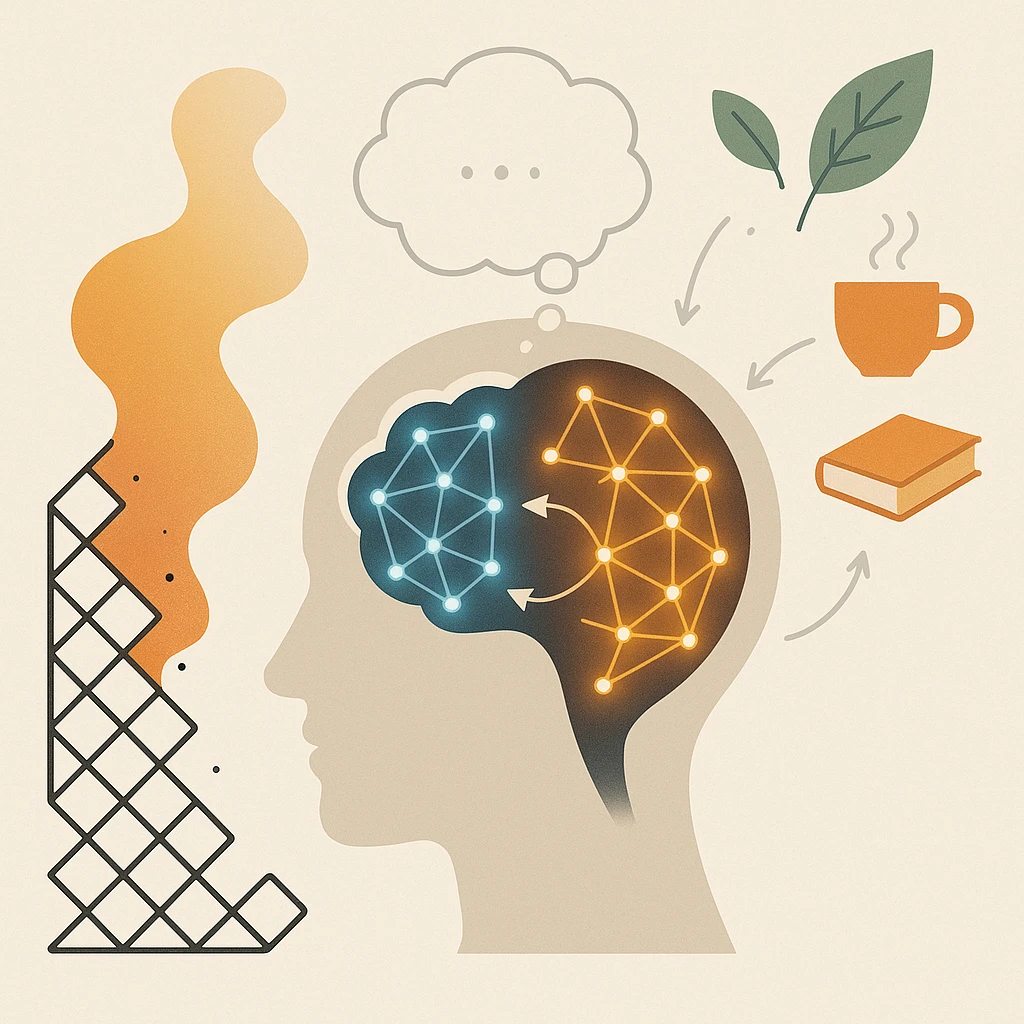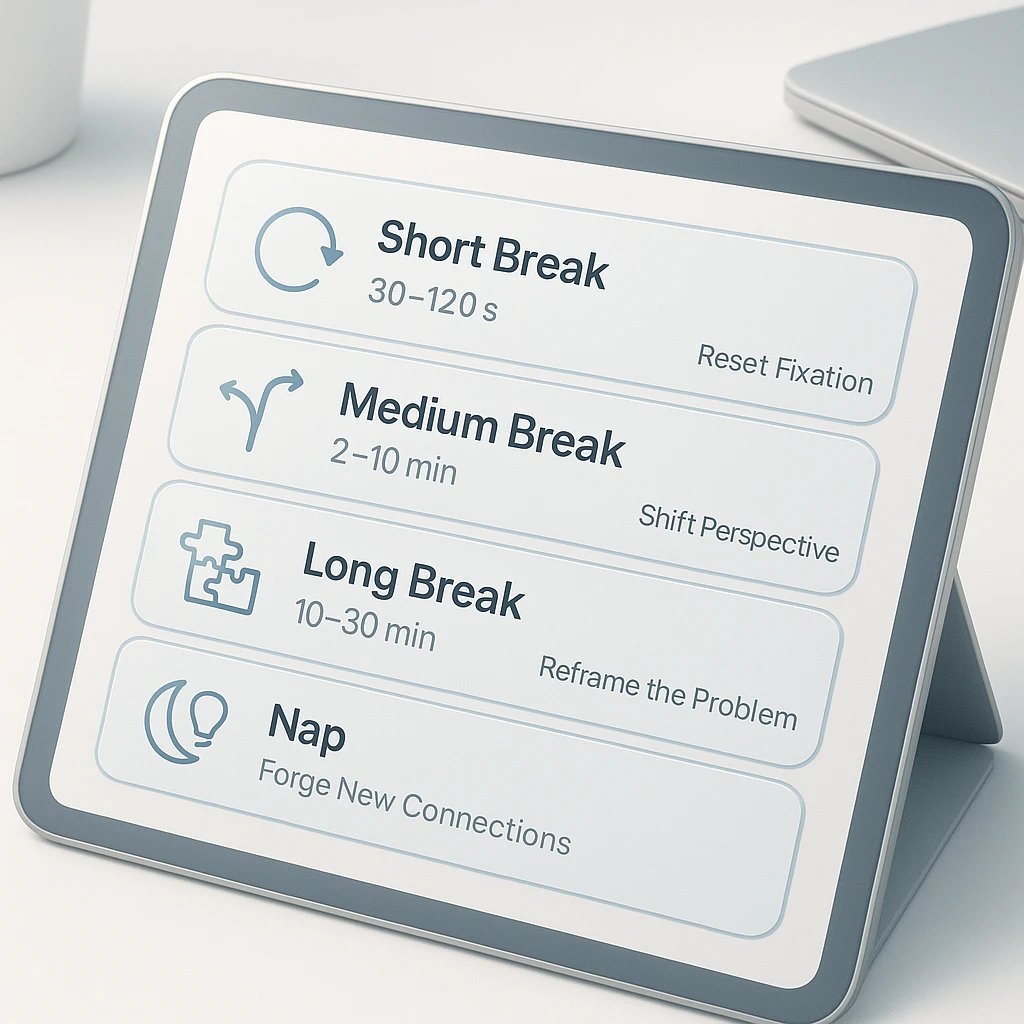When thinking alone doesn’t move things forward, you can sometimes set the task aside and, when you return after a while, it yields. Temporarily letting a difficult problem slip out of conscious focus and then returning to it to gain a fresh insight is called incubation.
A common example: you can’t settle on an idea for a work proposal, but while taking a walk for a change of pace, a new structure pops into your head and, afterward, the proposal comes together smoothly. Similarly, when you’re stuck at work, a restroom break or a shower—time alone in a low‑stimulation environment—helps you relax, the hurdles that made the problem feel intractable fall away, and good ideas surface. This kind of phenomenon is called the incubation effect.
We sometimes meet people with abundant creativity, but in neuroscience and the fields of psychology and cognitive science, the brain structures underlying high creativity are said to be largely unresolved. Humans are mysterious indeed.
Here I carefully organize, to the extent revealed by experimental research and meta‑analysis, this phenomenon of “focusing hard on a difficult problem, stepping away, and returning with a flash of insight.” To give the conclusion up front: short disengagements can indeed boost ideation and insight, but their effectiveness is conditional.
Task type, the intensity of the load while you’re away, how much perseverance you invested before stepping away, and the length of the rest all matter. In other words, rather than chasing a single “correct” answer for how many minutes to rest, it’s more useful in practice to design when to step away and what to do while away. Below I summarize how to use this effect, with evidence.
Stepping Away Can Help, but It Depends on Conditions

On average, to obtain the incubation effect, letting the problem drop from conscious focus yields small‑to‑medium positive effects.
In meta‑analyses of past research, the effect was larger for tasks that ask you to generate many possible uses/ideas, and the lower the cognitive load while you’re away, the more likely a flash of insight.
It has also been reported that having engaged in some trial‑and‑error before the break increases the return on stepping away.
Conversely, if you insert highly demanding mental activities while away, the effect can weaken. Everything up to this point reflects group‑average trends, and the effect varies with individual differences and task characteristics.
Several experiments show that by switching to “simple, boring tasks,” the mind naturally tends to wander, and ideation expands upon resumption. This means that, in some situations, creating white space for thought is more advantageous than continuing to think hard. However, this doesn’t apply to all tasks. For tasks with easy associations, working continuously may yield little added benefit.
Why Does “Stepping Away” Work? Three Lenses on the Mechanisms

First, stubborn fixations loosen their grip.
Studies show that, after stepping away and returning, you’re less likely to be dragged by an initially mistaken strategy. The strength of this account is its simplicity and clarity; its limitation is that for problems not dominated by strong fixations, the effect is small.
Second, serendipitous cues in the environment become easier to pick up. The idea is that when you keep the unresolved question on the mental back burner while encountering different stimuli, something you happen to see mixes with your framework of thought and triggers a solution. For example, while you’ve closed the book and are out walking, a single word on a sign becomes the breakthrough.
This is a commonly cited theory about what tends to happen during the time away.
Third, brain networks switch.
Creative thinking is supported by a collaboration between the network for internally oriented associations (the default mode network) and the network for selection and inhibition (the executive control network). During rest, the associative side is more active; after you return, the selection side tends to engage—this role alternation can broaden ideation and help you revise your choices.
There are also reports that people with higher creative ability switch between these networks more flexibly.
Furthermore, short periods of quiet wakeful rest with eyes closed have been reported to help preserve newly learned memories.
This suggests a foundation‑protecting effect against the worry that information will fade while you’re away. It has been reported that a few minutes of quiet rest increase later recall and insight. However, if the amount of material is too small, the effect may be limited.
Let’s also touch on sleep. Very short sleep right at sleep onset has been reported as a time window that favors insight. Meanwhile, REM sleep, when we tend to dream, may strengthen connections between remote pieces of information. That said, sleep doesn’t benefit every kind of task, and some reports find no difference for classical insight problems. Here, too, it depends on task type and conditions.
Conditions That Foster the Incubation Effect—and Those That Don’t
Switching to simple tasks or quiet rest can increase the number of ideas and the breadth of ideation when you resume. Conversely, exposing yourself to heavy judgments or intense information while away can dilute the incubation effect.
Preparation length also matters: stepping away after you’ve worked carefully for a while yields a larger return when you come back.
For tasks centered on insight, difficulty and the strength of fixation are key. For easy associative problems, continuous solving may show little difference, whereas for hard problems that easily trap you with misleading cues, letting the problem leave conscious focus can offer large advantages. You can use whether you need to change your approach as a practical signal.
Incubation also shows large individual differences. The ability to switch between a state that expands ideas and a state that evaluates and selects varies by person. Neuroimaging studies show that people who are good at creating flexibly re‑wire both networks as needed. If creating isn’t your strong suit, first adjust how you spend the time away; if that’s still difficult, then revisit how long you stay away—that order is realistic.
What to Do “During” the Break: Actions That Work, Actions to Avoid
The safest and easiest option to try is low‑stimulation, low‑load ways of spending the break. Sit quietly with your eyes closed, step away from your desk and walk slowly, look at distant greenery—these lower the mental noise. The key is not to deliberately think the problem through again. Intentional rumination can strengthen your original fixation.
Social media and news, which we tend to open out of habit, easily bring in strong stimuli and unfinished topics, which can make it harder to return to focus when you resume work. Some research suggests that brief exposure can refresh mood, but if you’re aiming for incubation, spending quiet time is a better match. Prioritize light non‑work activity or eyes‑closed rest, and if you must consume information, keep it short.
For instance, when you’re stuck on the structure of a draft, insert a small step‑away such as “close the headings and step onto the balcony for only 2–3 minutes of fresh air.” When you return, limit yourself to just the first paragraph. If it goes well, your mind slips out of the fixed frame, and the next step becomes visible. The point is to step away briefly and return lightly.
How Long to Step Away: Think in Ranges, Not a “Right” Number of Seconds

The research does not assert “this number of seconds is optimal.”
Instead, it indicates that combinations of conditions determine the effect. As a guideline, it’s worth trying the following time ranges.
Below are practical, easy‑to‑choose benchmarks you can use right now.
Very short: 30–120 seconds
Use when signs appear that your thinking is beginning to harden—re‑reading the same sentence, drifting back to the same steps.
Examples: stand up once from your chair / close your eyes and take a few slow breaths.
Aim: reset attention that has tilted in one direction.
Short break: 2–10 minutes
When you feel indecision increasing or your field of view narrowing, aim for a perspective switch.
Examples: walk slowly down the hallway / look at a distant view outside the window / wash your hands.
Tip: avoid new information such as news or social media (strong stimuli make returning harder).
Aim: loosen associations while keeping the work context.
Moderately long: 10–30 minutes
Use when you need to change the very “frame” of the problem. Encourage recombination of the parts in your head.
Risk: context can fade.
Countermeasure: upon return, write just the “first sentence” → fix the next step before continuing.
Very short nap
Doze for a few minutes right before sleep onset. There are reports that this makes it easier to sprout new connections.
How to try: use a 1–3 minute timer / lightly pinch a pen and use the drop as a cue to wake.
Note: if you sleep too deeply or too long, you may feel groggy at restart and the ramp‑up can be heavy.
Additionally, REM sleep, the stage in which dreams are common, may strengthen connections between remote pieces of information. However, depending on the task, there may be no effect—or even the opposite.
In conclusion, treat daytime short “step‑aways” (the three ranges above plus short naps) and sleep‑based methods as different tools, and switch between them to suit the situation.
Summary
Stepping away from a problem and returning can indeed produce flashes of solutions. However, how it works varies with the combination of task nature, the load while away, how much you worked before stepping away, and the length of the rest.
Low‑load ways of stepping away (quiet rest, slow walking, etc.) tend to support ideation and insight, while high‑stimulation activities can weaken the effect.
For difficult problems prone to fixation, short‑to‑medium step‑aways make it easier to reframe. When resuming, decide “the first small step” in one sentence and start moving your hands; this makes returning easier.
There is no single correct number of seconds, so it’s practical to decide on ranges ahead of time, test small, and adjust based on the feel. Short naps and REM sleep vary in effectiveness by task and conditions, so use them differently from daytime short step‑aways for safety.
The Flowtime Technique Is an App That Supports Focus Time
We provide a free app that lets anyone practice the Flowtime Technique, which helps maintain concentration and automatically calculates break durations based on your work time. Try it from the home page.
References
- Does incubation enhance problem solving?
- Inspired by distraction: Mind wandering facilitates creative incubation
- Incubation and the persistence of fixation in problem solving
- Demystification of cognitive insight: Opportunistic assimilation and the prepared‑mind perspective
- Creative cognition and brain network dynamics
- Robust prediction of creative ability from brain networks
- Evaluative and generative modes of thought during the creative process
- Dynamic switching between brain networks predicts creative ability
- Brief wakeful resting boosts new memories over the long term
- Boosting long-term memory via wakeful rest
- Rest on it: Awake quiescence facilitates insight
- Sleep onset is a creative sweet spot
- REM, not incubation, improves creativity
- Sleep inspires insight
- Sleep does not promote solving classical insight problems
- Targeted memory reactivation during sleep improves next‑day problem solving
- Wakeful rest benefits recall
- Effects of post‑encoding wakeful rest and study time
- Wakeful rest and consolidation
- Different incubation tasks in insight problem solving
- Incubation and interactivity in insight problem solving
- Partly vs completely out of your mind
- Creativity and the default network
- Network neuroscience of creative cognition
- Insights into sleep’s role for insight
- Incubation, not sleep, aids problem‑solving
- Targeted memory reactivation of newly learned words
- The effects of incubation task characteristics on idea novelty
- Memory for impasses during problem solving
- Fixation and creativity in concept development
- Design fixation: Classifications and prevention
- Time decay of fixation
- Creativity and fixation in the real world
- Trade‑off between fixation and quality
- The role of the DMN in creativity
